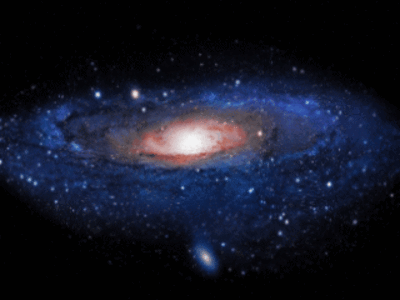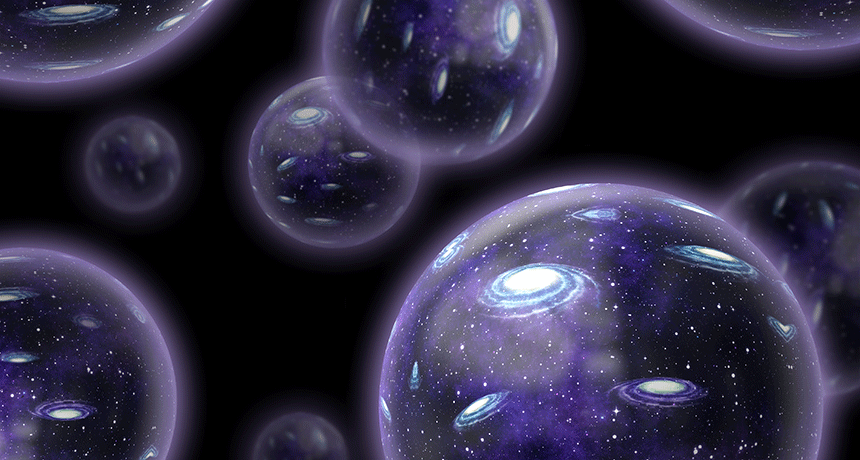 |
 |
 |
 |
 |
Endless Quilted Doppelgangers
The cosmological principle says that if the universe is examined on the largest of scales, it will appear uniform. In Einstein's day, evidences in support of the cosmological principle were small at best, but he was guided by a strong sense that no location in the universe was special. He felt that, on average, every region of the universe should have essentially identical overall physical qualities. In the years since, astronomical observations have provided considerable support for the cosmological principle, but only if you examine space on scales at least 100 million light-years across (which is about a thousand times the end-to-end length of the Milky Way). If you take a box that's a hundred million light-years on each side and put it down here, take another such box and put it down over there (say a billion light-years from here), and then measure the average overall properties inside each box - average number of galaxies, average amount of matter, average temperature, and so on - you'll find it difficult to distinguish between the two. In short, if you've seen one 100-million-light-year chunk of the cosmos, you've pretty much seen them all.
If space is large but finite, we can divide it into a large but finite number of such independent patches. If space is infinite, then there are an infinite number of independent patches. It's this latter possibility that's of particular appeal, and the second part of the argument tells why. As will now see, in any given patch the particles of matter (more precisely, matter and all form of energy) can be arranged in only a finite number of different arrangements. This means that conditions in the infinity of remote patches in areas like the one we inhabit but distributed through a limitless cosmos.
Finite energy within a cosmic horizon requires a finite number of particles, be they electrons, protons, neutrons, or any of the other know or as yet unidentified. Finite energy within the cosmic horizon also entails that each of these particles has a finite number of distinct possible locations and speeds.
Collectively, a finite number of particles, each of which can have finitely many distinct positions and velocities, means that within any cosmic horizon only a finite number of different arrangements are available.
But the same reasoning, the limited number of particle arrangements ensures that with enough independent cosmic horizons the particle arrangements, when compared from patch to patch, must somewhere repeat. Even if you were able to design the cosmos and tried to arrange each patch to be different from the ones you'd examined before, with a big enough expanse you'd eventually turn run out of distinct designs and would be forced to repeat a previous arrangement.
In an infinitely big universe, the repetition is yet more extreme. These are infinitely many patches in an infinite expanse of space; so, with only finitely many different particle arrangements, the arrangements of particles within patches must be duplicated an infinite number of times.
This means that if the universe is infinite in extent there are many perfect copies of you out there in the cosmos, feeling exactly the same way. And there's no way to say which is really you. All versions are physically and hence mentally identical.
Still easier to find are approximate copies. After all, there is only one way to duplicate a region exactly, but many ways to almost duplicate it.
 |
Since the microwave background radiation is uniform throughout space, it provides convincing observational evidence for the cosmological principle, and strengthens our confidence in conclusions of the principle helped reveal.
In the big bang theory, however, the explanation fails. For things to reach a common temperature, an essential condition is mutual contact. Hypothetical observers situated at distant left and right locations have yet to see each other, and since the speed of light sets the upper limit for how fast anything can travel, they've yet to interact in any way. They are beyond each other's event horizon.
The speed limit of light set by light refers solely to the motion of objects through space. But galaxies recede from one another not because they are travelling through space but because space itself is swelling and the galaxies are being dragged along by the overall flow. The rate of recession between any two galaxies can exceed any speed, including the speed of light.
In inflationary theory, the burst of spatial expansion is not a onetime event. Instead, the process by which our region of the universe formed - rapid stretching of space, followed by a transition to more ordinary, slower expansion, together with the production of particles may happen over and over again at various far-flung locations throughout the cosmos. Our realm, that we have always thought of as the universe, would be but one of these numerous regions, floating within a vastly larger spatial expanse.
The holes are regions that have transitioned out of the superfast expansion and, in the process, converted the inflations energy into a bath of particles, which over times may coalesce into galaxies, stars, and planets. We've found that the they acquire more and more holes because quantum processes knock inflation's value downward at a random assortment of locations. At the same time, it stretches ever larger because they're subject to inflationary expansion driven by high inflation field value they harbour. Taken together, the two processes yield an ever-expanding cosmos with an ever-growing number of holes. In the more standard language of cosmology, each hole is called a bubble universe.
Because of their fundamental differences, the Quilted and inflationary Multiverse might appear unrelated.
Each of the bubble universes appears to have finite spatial extent when examined from outside, but infinite when examined from the inside. Infinite spatial extent is just what we need for quilted parallel universes.

















